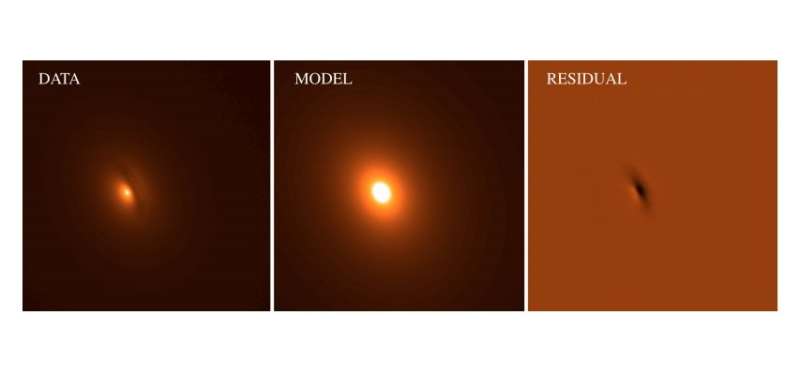The 2D bulge-disk decomposition of NGC 3665 with Galfit. Panels from left to right are r-band observed image, model image, and model-subtracted residual image. The black region in residual image shows a dust structure near the galaxy center, which has been masked out before the fitting. Credit: Xiao et al., 2018.
Using ESA's Herschel telescope a team of Chinese researchers has performed analysis of the interstellar medium in the early-type galaxy NGC 3665. The study offers insights into physical properties of the matter between its star systems. The results were presented January 16 in a paper published on arXiv.org.
Discovered by William Herschel in 1789, NGC 3665 is a lenticular early-type galaxy located some 108 million light years away. However, contrary to typical early-type galaxies, NGC 3665 is abundant in cool gas and has a low star formation rate surface density. Studying gas, dust and other matter in this galaxy, especially in its interstellar medium, could therefore explain the galaxy's low star formation efficiency.
A group of astronomers led by Meng-Yuan Xiao of the Nanjing University in China, has carried out an analysis of the physical properties of the interstellar medium in NGC 3665. For their research, they used far-infrared photometric and spectroscopic data obtained by ESA's Herschel Space Observatory – an infrared telescope operating in space from 2009 to 2013. The dataset provided by Hershel was complemented by observations conducted with the Calar Alto Observatory (CAHA) in Spain.
The observational campaign allowed the researchers to physically characterize NGC 3665's interstellar medium by obtaining its fundamental parameters, which could improve our understanding of this atypical galaxy and star formation process taking place there.
"In this paper, we focus on the photometric observations of NGC 3665 at 100, 160, 250, 350 and 500 µm, obtained with the Photodetector Array Camera and Spectrometer (PACS; – 4 – Poglitsch et al. 2010) and the Spectral and Photometric Imaging REceiver (SPIRE; Griffin et al. 2010) onboard Herschel, with five fine-structure lines of [N ii] 122 and 205 µm, [C ii] 158 µm, [O i] 63 µm, and [C i] 370 µm. We also perform optical spectroscopic observations of NGC 3665 with the CAHA 3.5m telescope," the scientists wrote in the paper.
According to the study, the researchers found that neutral and ionized gas in NGC 3665 have extended structures and follow the carbon monoxide line gas disk distribution, adding that the fluxes are stronger at the center.
Furthermore, Xiao's team estimates that the dust-to-stellar mass ratio of NGC 3665 is about 0.0011, which is nearly three times larger than the mean value of local lenticular galaxies. When it comes to the gas-to-dust mass ratio, this value is approximately 182, similar to that in our Milky Way galaxy.
According to the authors of the paper, these findings, together with the calculated star formation rate of around 1.7 solar masses per year, suggest that NGC 3665 has large gas reservoirs and less star formation.
Moreover, the researchers found that NGC 3665 has a weak active galactic nucleus in its central region, a very weak ultraviolet radiation field and has the lowest gas heating efficiency in photodissociation regions among different kinds of galaxies. The astronomers conclude that the new findings, compared with results provided by previous studies, indicate that suppressed star formation in NGC 3665 is most possibly caused by its compact, massive bulge through stabilizing cool gas reservoirs.
More information: The Physical Characteristics of Interstellar Medium in NGC 3665 with Herschel Observations, arXiv:1801.05110 [astro-ph.GA] arxiv.org/abs/1801.05110
Abstract
We present the analysis of the physical properties of the interstellar medium (ISM) in the nearby early-type galaxy NGC 3665, based on the far-infrared (FIR) photometric and spectroscopic data as observed by the Herschel Space Observatory. The fit to the spectral energy distribution reveals a high dust content in the galaxy, with the dust-to-stellar mass ratio of Mdust/M∗ ∼ 1.1 × 10−4 that is nearly three times larger than the mean value of local S0+S0a galaxies. For the ionized regions (H~textsc{ii} regions), the electron density (ne) is around 49.5 ± 11.9 cm−3 based on the [N~textsc{ii}],122,mum/[N~textsc{ii}],205,mum ratio. For the photodissociation regions, the heating efficiency is in the range of 1.26 × 10−3 and 1.37 × 10−3 based on the ([C~textsc{ii}]+[O~textsc{i}],63,mum)/LTIR, which is slightly lower than other local galaxies; the hydrogen nucleus density and the strength of FUV radiation field are n ∼ 104 cm−3 and G0 ∼ 10−0.25, respectively. The above results are consistent with the presence of weak AGN and a low level of star-forming activity in NGC 3665. Our results give strong support to the `morphological quenching' scenario, where a compact, massive bulge can stabilize amount of cool gas against star formation.
© 2018 Phys.org
























